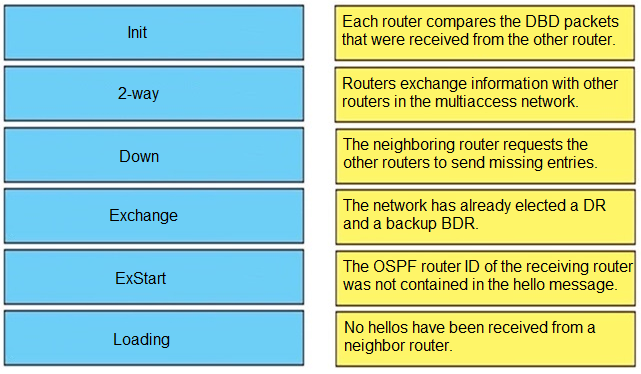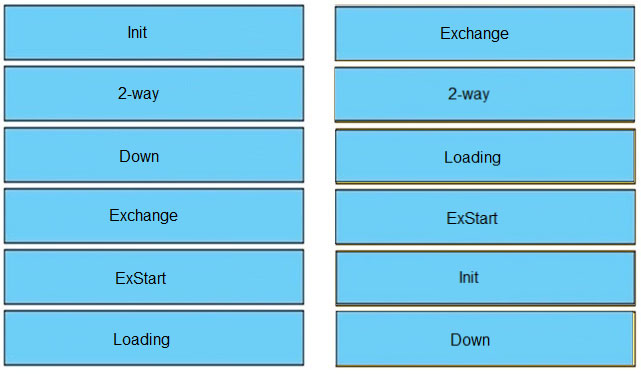DRAG DROP -
Drag and drop the OSPF adjacency states from the left onto the correct descriptions on the right.
Select and Place:

DRAG DROP -
Drag and drop the OSPF adjacency states from the left onto the correct descriptions on the right.
Select and Place:


Reference:
https://www.cisco.com/c/en/us/support/docs/ip/open-shortest-path-first-ospf/13685-13.html
1) Exchange - Routers exchange database descriptor (DBD) packets. Contents of the DBD received are compared to the information contained in the routers link-state database. 2) 2-Way - Each router has seen the other's hello packet. At the end of this stage, the DR and BDR for broadcast and non-broadcast multiacess networks are elected. 3) Loading - The actual exchange of link state information occurs. If a router receives an outdated or missing LSA, it requests that LSA by sending a link-state request packet. 4) Exstart - The routers and their DR and BDR establish a master-slave relationship. 5) Init - Specifies that the router has received a hello packet from neighbor, but receiving router's ID was not included in the hello packet. 6) Down - No Hellos have been received ------------------------ Given Answer is correct. Link: https://www.cisco.com/c/en/us/support/docs/ip/open-shortest-path-first-ospf/13685-13.html#intro
I agree on this solution.
Are you guys sure about that? If you look, what you say shoulr be 2 way says that the DR and BDR have already been elected. The article referenced for ExStart says "Once the DR and BDR are elected, the actual process of exchanging link state information can start between the routers." That to me suggests that the DR and BDR have already been elected.
If this order is correct, their description of the 2-way state is awful.
The given answer is correct
It sounds right to me, Exchange is where DBD are compared
correct
Given Answer is correct: Down: This is the first OSPF neighbor state. It means that no information (hellos) has been received from this neighbo Init This state specifies that the router has received a hello packet from its neighbor, but the receiving router ID was not included in the hello packet 2-way On broadcast media and non-broadcast multi-access networks, a router becomes full only with the designated router (DR) and the backup designated router (BDR); it stays in the 2-way state with all other neighbors Exstart Once the DR and BDR are elected, the actual process of the exchange link state information can start between the routers and their DR and BDR. Exchange In the exchange state, OSPF routers exchange database descriptor (DBD) packets Loading routers send link-state request packets. Link: https://www.cisco.com/c/en/us/support/docs/ip/open-shortest-path-first-ospf/13685-13.html
Down:No hellos have been received from a neighbor router. init: The OSPF router ID of the receiving router was not contained in the hello message 2 way: Routers exchange information with other routers in the multiaccess network Exchange:Each router compares the DBD packets that were received from the other router ExStart:The network has already elected a DR and a backup BDR Loading:The neighboring router requests the other routers to send missing entries
The description for 2-way and Exstart is horrible.
Given answer is correct.
Given answer is correct
Down and Loading need to be swapped around
The given answer is correct
Unless answer was corrected in the meantime, at this very moment it is correct the way it is. Nothing should be swapped IMO
The given answer is correct: http://www.firewall.cx/networking-topics/routing/ospf-routing-protocol/1142-ospf-adjacency-neighbor-states-forming-process.html
exchange and 2 way should be swapped. Exchange information should be mentioning the exchange stage, which "choose the initial sequence number for adjacency formation"
true, 2 way and Exstart need to be swapped.